Now that you're monitoring blogs, product reviews and domain name registrations, have you considered Wikipedia?
If you aren't familiar with it, Wikipedia is the free, community-edited, online reference that has taken a primary place in many people's reference library. It's a great resource with information on many, many topics. Its greatest strength is also the problem—anyone can edit it, and the information isn't always accurate. If you're using it as a source for a history paper, you're risking a bad grade. What if people are getting misleading information on your products?
I was talking to an executive at a large industrial company last week, when he told me about an ongoing problem they have on Wikipedia. It seems that a product his company invented is credited to a company that licensed it from them, and another product is listed under a competitor's trade name in Wikipedia. In theory, the generic term should be listed, with trade names listed as examples. But they've been unable to make corrections stick, so far. Since people use (and many trust) Wikipedia, the company needs to get the entries corrected, but the process isn't always as simple as it looks. As they deal with this, his team is becoming expert on Wikipedia.
For a happier example, Dan Pink recently learned that his book is in Wikipedia (I would link to the post, but Dan's item archive links never work for me):
A Whole New Wiki?
A Whole New Mind has its own Wikipedia entry. In fact, it's had one since June. Of course, I didn't know until this weekend when, er, my ten-year-old daughter showed me. Cool.
The entry on
A Whole New Mind presents the book in a good light, and it includes links to entries on Pink himself and his first book,
Free Agent Nation. Those entries don't exist (yet). Should Dan write something? I think I would, but I would keep it short and factual—not a big promotional page. Look at entries for other living people as a guide, but the fact that someone created a page for his book suggests that a brief biography entry is appropriate.
Monitoring Wikipedia for your business
If you're responsible for your company's image, Wikipedia is just one more place to know what's being said about you. Our corporate example demonstrates the importance of looking up your competitors, too, since you or your products may appear on pages about them. Here are some steps for getting started:
- Look up your company, products, inventions, brands, and people on Wikipedia. Do the same for other companies in your ecosystem: competitors, partners, suppliers and customers. Take note of any entries that present a problem. You may be involved with these pages for a while.
- Browse the Help section and read a good selection of entries before you start making changes. Wikipedia is like other Internet subcultures that want newcomers to learn their ways before making noise.
- Anyone can edit Wikipedia entries. If you find simple errors, fix them. Then monitor that page to see if the errors return. Be sure to see the Discussion and History tabs at the top of each entry.
- Set up an account on Wikipedia. Registered users can create new pages and set up watchlists to track changes to Wikipedia entries.
- Just to keep things interesting, remember that Wikipedia exists in multiple languages. You'll need to track them individually.
YouTube may get all the attention (and Google's money), but Wikipedia is the kind of low-profile, apparently objective, information source that potential customers could rely on when they're getting ready to buy. Will they find your product there? Wikipedia is
not the place for a sales-oriented pitch, but it shouldn't be the place for inaccurate, adverse information, either.
Update: I posted more thoughts and some updates in Crash course on Wikipedia.

 FedEx clearly understands how to use the web for their business. The corporate site is simply
FedEx clearly understands how to use the web for their business. The corporate site is simply  I've been clearing out some of the backlog in my downloads folder this morning and finally watched
I've been clearing out some of the backlog in my downloads folder this morning and finally watched 


